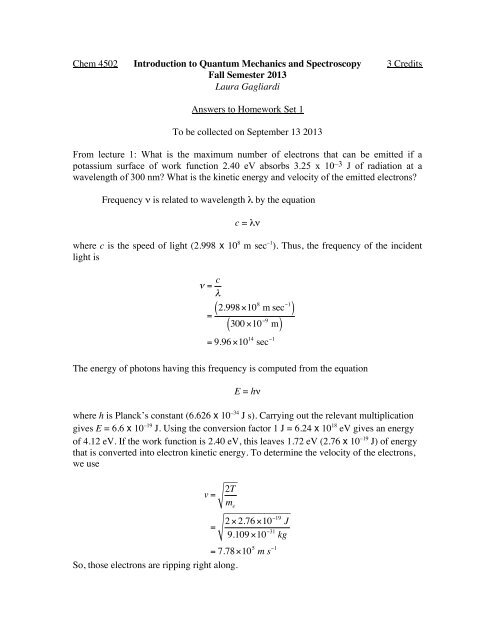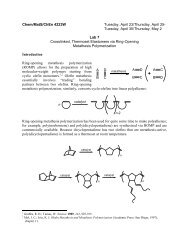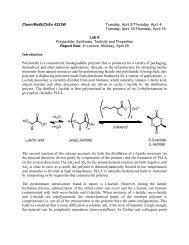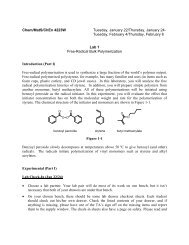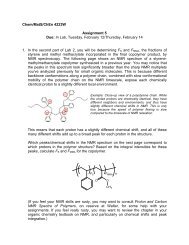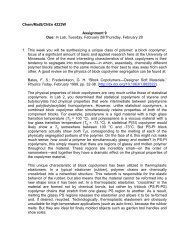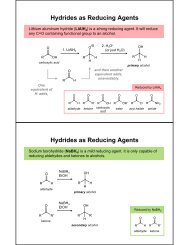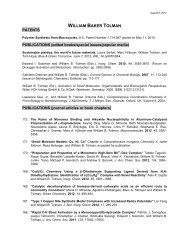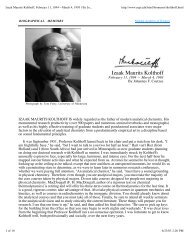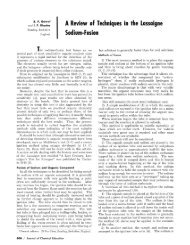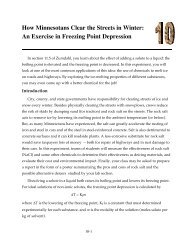Chem 4502 Introduction to Quantum Mechanics and Spectroscopy 3 ...
Chem 4502 Introduction to Quantum Mechanics and Spectroscopy 3 ...
Chem 4502 Introduction to Quantum Mechanics and Spectroscopy 3 ...
Create successful ePaper yourself
Turn your PDF publications into a flip-book with our unique Google optimized e-Paper software.
<strong>Chem</strong> <strong>4502</strong> <strong>Introduction</strong> <strong>to</strong> <strong>Quantum</strong> <strong>Mechanics</strong> <strong>and</strong> <strong>Spectroscopy</strong> 3 CreditsFall Semester 2013Laura GagliardiAnswers <strong>to</strong> Homework Set 1To be collected on September 13 2013From lecture 1: What is the maximum number of electrons that can be emitted if apotassium surface of work function 2.40 eV absorbs 3.25 x 10 –3 J of radiation at awavelength of 300 nm? What is the kinetic energy <strong>and</strong> velocity of the emitted electrons?Frequency ν is related <strong>to</strong> wavelength λ by the equationc = λνwhere c is the speed of light (2.998 x 10 8 m sec –1 ). Thus, the frequency of the incidentlight isν = c λ( )( )= 2.998×108 m sec −1300 ×10 −9 m= 9.96 ×10 14 sec −1The energy of pho<strong>to</strong>ns having this frequency is computed from the equationE = hνwhere h is Planck’s constant (6.626 x 10 –34 J s). Carrying out the relevant multiplicationgives E = 6.6 x 10 –19 J. Using the conversion fac<strong>to</strong>r 1 J = 6.24 x 10 18 eV gives an energyof 4.12 eV. If the work function is 2.40 eV, this leaves 1.72 eV (2.76 x 10 –19 J) of energythat is converted in<strong>to</strong> electron kinetic energy. To determine the velocity of the electrons,we usev =2Tm e= 2 × 2.76 ×10−19 J9.109 ×10 −31 kg= 7.78×10 5 m s −1So, those electrons are ripping right along.
HW1-2Now, if the <strong>to</strong>tal energy absorbed was 3.25 mJ, that would correspond <strong>to</strong> anumber of electrons n en e=3.25×10−3 J6.6 ×10 −19 J e −1= 4.92 ×10 15 eif every pho<strong>to</strong>n’s energy led <strong>to</strong> emission of an electron.As a note of his<strong>to</strong>rical interest, eV is usually the unit of choice in these mattersbecause one does not want <strong>to</strong> try <strong>to</strong> measure the kinetic energy of an electron! Instead,one would like <strong>to</strong> do the much simpler experiment of just seeing if there are electronsthere or not. So, one applies a biasing voltage <strong>to</strong> the metal <strong>and</strong> measures the voltage atwhich electrons no longer escape. The energy of interaction between one electron <strong>and</strong> apotential in volts is 1 eV (hence the name…), so when one finds the voltage V that turnsoff the electrons, one immediately knows that the electrons would have had the samevalue of kinetic energy, now in eV, if there were no retarding voltage.From lecture 2: For B 4+ what is the longest wavelength that can be emitted by an electronending in the n = 3 state?Using eq. 2-17 for transition frequencies, we recallν = ΔE m→nh= m e Z 2 e 4 & 18ε 2 0 h 3 n 2 − 1' m 2where for Be 3+ Z = 4. The longest wavelength emission corresponds <strong>to</strong> the least energydifference between the initial state <strong>and</strong> the final state. As the final state is n = 3, thenearest initial state is m = 4.This can be solved by looking up all of the relevant physical constants <strong>and</strong> gettingthe units right. I’ll do it in a slightly quicker fashion (at least for me). Hydrogen has anionization potential of 13.605 eV. Ionization potential corresponds <strong>to</strong> the differencebetween state n = 1 <strong>and</strong> state m = infinity, which makes the quantity in parentheses above1. So, the mess of constants out front times h corresponds <strong>to</strong> the energy 13.605 eV whenZ = 1. For B, Z = 5, so the prefac<strong>to</strong>r will be 25 times larger in B 4+ , corresponding <strong>to</strong>340.125 eV. Converting from this energy <strong>to</strong> frequency involves division by h (4.1357 x10 –15 eV s), which gives a frequency of 8.2241x 10 16 s –1 for the prefac<strong>to</strong>r. For thetransition itself, we must multiply this constant by (1/9 – 1/16) = 0.0486 which gives afrequency for the transition of 3.99 x 10 15 s –1 .()
HW1-3To compute wavelength λ we divide c by the last quantity <strong>to</strong> obtain (2.998 x 10 8m s –1 / 2.55 x 10 15 s –1 ) = 75 nm.For those who prefer the direct approach, the relevant physical constants are:m e = 9.109 x 10 –31 kge = 1.602 x 10 –19 Cε 0 = 8.857 x 10 –12 F m –1h = 6.626 x 10 –34 J sFrom Lecture 4: Which of the following functions are eigenfunctions of the opera<strong>to</strong>rsd/dx, d 2 /dx 2 , <strong>and</strong> what are their corresponding eigenvalues if they are? (a) ae –3x + be –3ix ,(b) sin 2 x, (c) e –x , (d) cos(ax), (e) sinx + cosx.Let us look at the various cases for d 2 /dx 2 . For d/dx it is even simpler. For thesefunctions <strong>to</strong> be eigenfunctions they must satisfy the following equation for all values ofthe independent variable xd 2dx 2 f x ( ) = Cf x ( )where C is a constant. So, <strong>to</strong> answer the question we simply need <strong>to</strong> apply the secondderivative opera<strong>to</strong>r. For the five functions listed, this gives€d 2dx 2d 2( ae−3x + be −3ix) = 9ae −3x − 9be −3ixd 2dx 2d 2( sin2 x) = 2( 1− 2sin 2 x)d 2dx 2( ) e−x = e −x[ dx 2 cos ( ax )]= −a 2 cos ax[ dx 2 sin( x)+ cos( x)] = − sin xEvidently, the first two functions are not eigenfunctions of the second derivativeopera<strong>to</strong>r, while the last three are, with eigenvalues of 1, –a€2 , <strong>and</strong> –1, respectively.( )[ ( ) + cos( x)]


